Sofía Ortega-García
Centro Interdisciplinario de Ciencias Marinas, Instituto
Politécnico Nacional
Apartado Postal 592
La Paz, Baja California Sur, México
ABSTRACT
The Mexican longline and purse seine fisheries logbook records from 1984 to 1990 were analysed to define a possible interaction between these two gears. Effort of the two fleets overlapped in only 37 1-degree squares by month during 1988. The seasonal peak fishing success for longline and purse seine differs. Although the information was not enough to define an interaction between gears, it is possible to suggest the presence of a "consecutive" interaction based on the analysis of length distribution. Longline catch rates were higher when the thermocline was deeper and could be one of the factors enhancing a possible interaction.
1. INTRODUCTION
Since the rapid development of the Mexican purse seine fleet in the eastern Pacific Ocean (EPO) in the 1980s, its participation has been important as much in volume of catch as for its carrying capacity. The Mexican fleet has maintained first place in tuna landings for the EPO since 1986 (IATTC, 1987, 1988, 1989, 1990, 1991, 1992a, 1992b, 1993, 1994).
In order to develop good management strategies for tuna fisheries, in recent years many governments have become interested in identifying the major types of interactions, the scientific problems related to them, and in reviewing interaction methodology (Shomura et al., 1994).
Yellowfin tuna in the EPO are considered to be a single stock and are fished primarily by purse seine. Additionally, yellowfin are also caught by a limited number of baitboats, longliners and trolling vessels (Shomura et al., 1994). Considering an interaction can occur between two fisheries operating in overlapping or separated fishing grounds and between fisheries harvesting the same or different size classes of life stages of the target species (Kleiber, 1994), one could postulate a potential exists for interaction between the different kind of gears in the EPO.
The interaction between the surface and longline fisheries in the EPO has been discussed by Suda and Schaefer (1965), Kume and Schaefer (1966), Kume and Joseph (1969), Shingu et al. (1974), Suzuki et al. (1978), Miyabe and Bayliff (1987), and Nakano and Bayliff (1992). In those studies the information of the Japanese longline fleet was used. The surface and longline fisheries have not fished in exactly the same areas. Also, fish caught by longlines are almost entirely large, whereas the surface fleet captures smaller yellowfin tuna (Nakano and Bayliff, 1992; Wild, 1994).
Although the Mexican longline fleet stopped fishing in 1990, it is important to examine the longline and purse seine interaction because of the possibility of future removal of the longline ban and the current existence of foreign longline fishing outside of Mexico's EEZ in the EPO.
2. MEXICO TUNA FISHERIES
2.1 Purse Seine
The Mexican purse seine fleet began in the 1960s, but its greatest development was in the 1980s. From 1984 to 1990 the fleet averaged 50 vessels annually, and individual vessels had carrying capacities that ranged between 350 and 1,270 mt. The most important were vessels in the 1,090 ton class (Ortega-García et al., 1992). The main species caught by the Mexican purse seine fleet has been yellowfin tuna (Table 1).
Table 1. Catch of main tuna species in the eastern Pacific Ocean by Mexican purse seine fishery from 1984 to 1990. Unit = metric tons.
|
|
YELLOWFIN TUNA |
SKIPJACK TUNA |
OTHERS |
|
1984 |
53,884 |
9,794 |
1,601 |
|
1985 |
80,591 |
6,148 |
1,298 |
|
1986 |
105,304 |
8,003 |
553 |
|
1987 |
99,355 |
6,625 |
626 |
|
1988 |
105,659 |
18,706 |
6,588 |
|
1989 |
118,137 |
18,129 |
11,426 |
|
1990 |
117,501 |
7,608 |
10,644 |
Data source: IATTC, 1984, 1985, 1986, 1987, 1988, 1989, 1990, 1991.2.2 Longline
The Mexican longline fishery began in 1980 with 11 vessels. By 1986, this fleet had 21 vessels with carrying capacities that ranged between 120 and 200 mt; each vessel fished from 120 and 2,500 hooks per day.
Although the target species of the longline fishery has been billfish, yellowfin tuna have been recorded in their catch (Macías-Zamora, 1993; Squire and Muhlia-Melo, 1993). Since billfish constitute an economically important resource, and one that is productive for recreational purposes, the Mexican government established protective measures to prevent over-exploitation of the billfish stocks. In 1972 the Mexican government established a sportfishing zone, which extended from the coastline to 30 nm offshore. In 1983, this zone was extended to 50 nm offshore. Following strong complaints by sportfishing operators, new regulations were issued in August 1987 that restricted longline operations to the offshore areas of Mexico's 200-mile zone; also additional protection areas were decreed (Squire and Au, 1990). Although the Mexican government cancelled permits for longliners in 1990, there are currently requests to re-establish this fishery.
2.3 Baitboat
Although the baitboat fishery is one of the oldest tuna fisheries in Mexico, its catch is relatively small compared with that of the purse seine fishery. The baitboat vessels are small, with a carrying capacity between 80 and 110 mt. During 1984 to 1990, the average number of active vessels was 12. The operational fishing area is limited to the west coast of Baja California and Islas Revillagigedo. As purse seiners also operate in this area, there is a potential for local interaction.
2.4 Troll and Artisanal Gear
Yellowfin tuna are also caught by the sport and artisanal fisheries. Although there is no systematic recording of the catches, the volume of fish taken by these fisheries is reported to be small.
3. METHODS
The information analysed was from the logbook records of the Mexican purse seine and longline fleets from 1984 to 1990. For the analysis of a potential interaction between the two gears, the information for 1988, because of its completeness, was used. Unfortunately, because of the lack of long time series of data it was not possible to apply the types of simulation models used by Boggs (1994) to detect the existence of an interaction between fisheries.
To compare the lengths of yellowfin tuna caught by both kinds of fishing gear, the areas determined by the Inter-American Tropical Tuna Commission (IATTC) were used (Figure 1). The weight data of yellowfin tuna caught by longline gear during 1988 was converted to length using the weight-length relation determined by Chatwin (1959). The length frequency recorded by the IATTC during 1988 for the yellowfin caught by the purse seine fleet was used for this comparison.
For the interaction analysis, the overlapping area, i.e., the zone where both fleets operated during the same month, was used. For this, the average monthly catch per standard day was used for the purse seiners and the average monthly number of yellowfin tuna caught by 100 hooks per month for the longliners. The standard effort for the Mexican purse seine fleet was estimated applying principal-component analysis as described by Ortega-García and Gómez-Muñoz (1992).
Taking into account that vertical thermal structure has an important effect on tuna distribution (Kawai, 1969; Suzuki et al., 1977) and that this environmental factor could have an effect enhancing the conditions for a major interaction between two gears, the profiles of temperature for the overlapping zone (averaged over the time of overlap) were analysed using a bathythermograph database consisting of data collected by fishing (commercial), military, and research vessels and tabulated by the National Marine Fisheries Service.
Figure 1. Areas used for sampling length of yellowfin tuna caught by the purse seine fleet in the EPO. Source: IATTC, 1989.
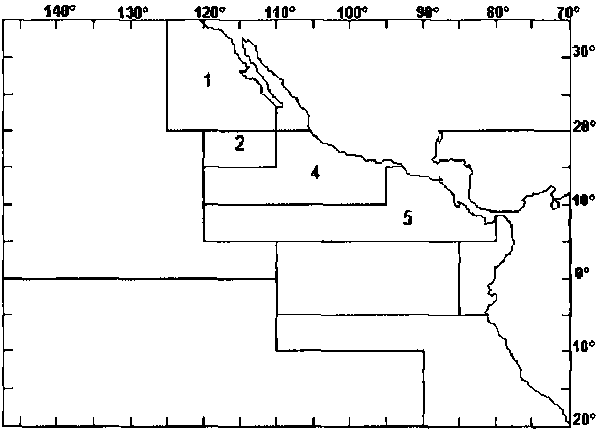
4. RESULTS
4.1 Longline Fishery
The fishing effort (number of hooks) distribution from 1984 to 1990 is shown in Figure 2 (top). The areas of greatest intensity were around Islas Revillagigedo and the mouth of the Gulf of California. However, in these areas the catch rate (number of yellowfin per 100 hooks) had low values; the highest values were found along the 10° north latitude line (between 94°-108° W.) as shown in Figure 2 (bottom).
Billfishes were the most significant portion of the catch (64%), while sharks made up 16.9% and tunas 7% of the catch. Among the tunas the yellowfin was the most important making up 94.3% of the tuna catch.
The size composition of the catch during 1988 is shown in Figure 3. The size of yellowfin tuna caught by the longline fleet was between 50 and 185 cm, although the length frequencies varied with fishing location. The fish caught in Area 1 were between 50 and 160 cm, with a prominent mode at 100 cm. In Area 2 the mode was at 130 cm and the average weight was 40 kg. Most of the fish caught in Area 4 were between 110 and 140 cm with a prominent mode at 120 cm. This mode was the same for fish caught in Area 5. The average weight was similar at 32 kg (Area 4) and 34 kg (Area 5).
Figure 2. Mexican longline fishing areas from 1984 to 1990. Top, fishing effort distribution, in number of hooks. Bottom, catch rate distribution, in yellowfin tuna per 100 hooks.

4.2 Purse Seine Fishery
The distribution of catches of yellowfin tuna from 1984 to 1990 for the Mexican purse seine fleet is shown in Figure 4. The fleet had the highest catch in nearshore areas, primarily around the Gulf of California, along the Mexican Pacific coastal waters, and along the 10° north latitude line (between 98° and 109° W.).
The samples taken by the IATTC during 1988 show most of the fish caught in Area 1 were between 46 and 94 cm in length, with a prominent mode centred at about 66 cm. In Area 2, most of the fish caught were between about 48 and 160 cm; the most prominent mode was centred at about 90 cm. In Area 4 the size range was about the same as in Area 2. There are three modes of about equal prominence at approximately 76, 92, and 112 cm. The size range for Area 5 was about the same as for areas 2 and 4. The most prominent mode is centred at 52 cm, with lesser modes at about 70 to 80, 90 to 94, 110 to 120, and 140 to 150 cm (IATTC, 1989).
4.3 Overlapping Zones
During 1988, longline and purse seine effort overlapped in 37 1-degree square by month strata among which there were 30 unique 1-degree squares. Average longline and purse seine catch rates for these squares are shown in Figure 5. These are all in IATTC Areas 2 and 4. Considering the size distribution of yellowfin tuna caught by longliners (Figure 3), this implies that most of the fish in the overlapping zone were larger than 120 cm. For both fleets, the squares of highest catch rate in 1988 are mostly not among the 30 overlapping squares (Figures 2, 4 and 5). The season of highest catch rate are likewise separated (Figure 6).
The average temperature profiles in the overlapping zone for three levels of catch rates for the longline fishery (Figure 7) shows longliners obtained better catches where the average temperature of the mixed layer was higher and the thermocline deeper.
Figure 4. Catch distribution of Mexican purse seine fleet from 1984 to 1990.
5. DISCUSSION AND CONCLUSIONS
The area of greatest intensity of fishing effort for longliners has been reported as one of the areas with the highest catch per unit effort for striped marlin (Squire and Suzuki, 1990). The Japanese longliners operated in this area from 1981 to 1987 and applied fishing effort that exceeded 500,000 hooks per quarter each year. These areas, primarily around Islas Revillagigedo, have been reported by the Japanese longline fishery as areas of high catch for striped marlin, swordfish, black marlin, sailfish, and shortbill spearfish; the catch rate (catch/100 hooks) exceeded 0.1. The catch rate was 1.0 for bigeye and less than 1.0 for yellowfin tuna (Nakano and Bayliff, 1992). In this study, the values of catch rates in these areas were generally less than 0.25, which is a low value considering purse seiners catch the largest amounts of yellowfin in these areas (Calkins, 1975; Orange and Calkins, 1981). The 1-degree areas with more than 100 tons of average annual catch from 1984 to 1990 are shown in Figure 4.
Bearing in mind that the longline catch and hook rates are not necessarily reliable indicators of abundance of yellowfin tuna because the Mexican fishery tried to catch billfish primarily and the number of yellowfin tuna caught was small compared with other species, it is important to know if the fishing areas overlap when the two kinds of gear were operating and what amount of yellowfin tuna was caught.
Although this analysis used the 1-degree squares where the two kinds of gear operated in the same month, the information was insufficient for a comprehensive study of longline and purse seine interaction. Based on the results of length distribution, one can suggest a "consecutive" type of interaction, i.e., an impact on longline fishery occurs some time after the purse seine fishery catches yellowfin tuna. In agreement with Kleiber (1994), it is not necessary for two fisheries to target the same size range or life stage of the fish for competitive interaction to occur. If fish are exposed to a series of fisheries as they grow in size or pass through stages of their life cycle, a consecutive interaction could be present. In this case, it could be possible the interaction occurs even if effort does not overlap in time. Furthermore, given that tuna can migrate from one area to another or exchange diffusively between two regions, it is possible for these fisheries, located at some distance from one another, to interact competitively (Kleiber, op cit).
Figure 5. Catch rates in overlapping areas for Mexican longline and purse seine fisheries during 1988. Catch rates in each square are averaged over the whole year.
Longline, in yellowfin tuna per 100 hooks.
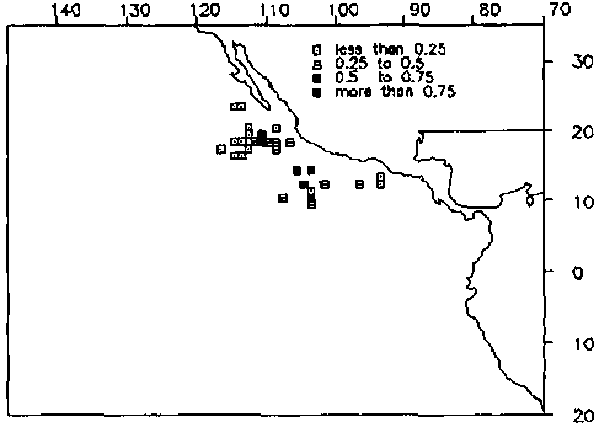
Purse seine, in tons per standard day fishing.
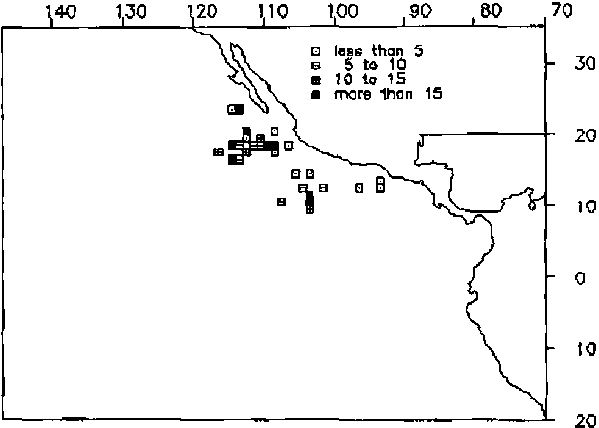
It is obvious there are a number of factors playing important roles in the interaction between longline and purse seine fisheries, including factors related to the physical environment. Of these, temperature could be one of the most important influences on tuna distribution (Kawai, 1969; Suzuki et al., 1978; Sund et al.,1981). Green (1967) showed a combination of sharp gradient and shallow thermocline gave the highest success rate in purse seine fishing. In this study, we found the catch rate for longliners was higher when the average mixed layer temperature was high (which was expected if we consider in this the thermocline is deeper and yellowfin could be more vulnerable to fishing with this kind of gear). If the mixed layer temperature is higher, yellowfin tuna could be in deeper waters. This factor could enhance a possible interaction.
Figure 6. Seasonal fishing success in the overlapping areas for longline and purse seine.
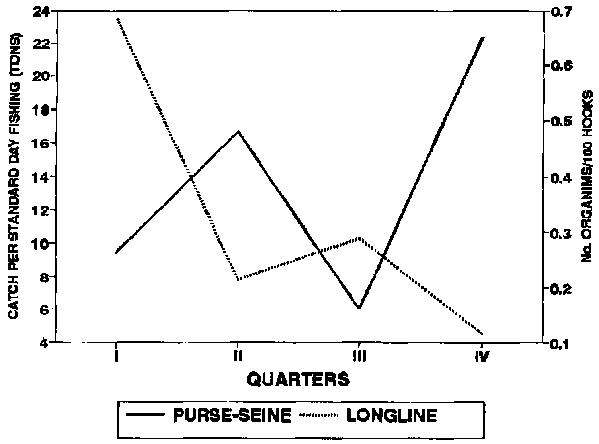
Although the longline catch rates of yellowfin tuna were lower, a large number are fish having the same size as those caught by the purse seine fleet. At present, the Mexican longline fleet is not operating because of problems with its interaction with recreational fishing. In the event the Mexican longline fishery resumes fishing operations, it may try to avoid problems with the sportfishing industry by targeting non-billfish species. If this happens, it is recommended that data collection should be continued in such a way to permit determination of the potential interaction between surface and longline fisheries.
6. ACKNOWLEDGMENTS
I would like to special thank to P.K. Tomlinson and Dr. Pierre Kleiber for critical reviews of earlier drafts of this paper and to Dr. Ellis Glazier for helping with the English language edition. Thanks are also extended to the Instituto Politécnico Nacional (COFFA-IPN) for their support.
Figure 7. Average temperature profiles associated with yellowfin tuna catch rates in the interaction zone (Mexican longline fishery).
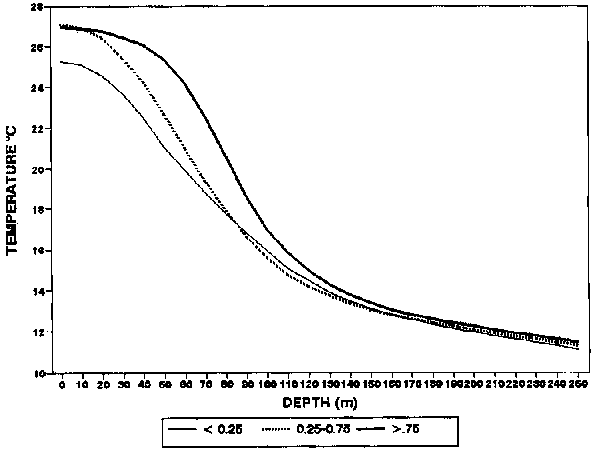
7. REFERENCES CITED
Boggs, C.H. 1994. Methods for analyzing interactions of limited-range fisheries: Hawaii's pelagic fisheries. In: Shomura, R.S., J. Majkowski and S. Langi (eds.). Interactions of Pacific tuna fisheries. Proceedings of the First FAO Expert Consultation on Interactions of Pacific Tuna Fisheries, 3-11 December 1991, Noumea, New Caledonia. Vol 1: Summary report and papers on interaction. FAO Fish. Tech. Pap. (336/1): 74-91.
Calkins, T.P. 1975. Geographical distribution of yellowfin and skipjack tuna catches in the eastern Pacific Ocean, and fleet and total catch statistics, 1971-1974. Bull. Inter-Amer. Trop. Tuna Comm. 17(1): 1-116.
Chatwin, B.M. 1959. The relationships between length and weight of yellowfin tuna (Neothunnus macropterus) and skipjack tuna (Katsuwonus pelamis) from the eastern tropical Pacific Ocean. Bull. Inter-Amer. Trop. Tuna Comm. 3(7): 305-352.
Green, R.E. 1967. Relationship of the thermocline to success of purse seine for tuna. Trans. Am. Fish. Soc. 96: 126-130.
IATTC. 1985. Annual report of the Inter-American Tropical Tuna Commission, 1984. Ann. Rep. I-ATTC (1984): 270 p.
IATTC. 1986. Annual report of the Inter-American Tropical Tuna Commission, 1985. Ann. Rep. I-ATTC (1985): 248 p.
IATTC. 1987. Annual report of the Inter-American Tropical Tuna Commission, 1986. Ann. Rep. I-ATTC (1986): 264 p.
IATTC. 1988. Annual report of the Inter-American Tropical Tuna Commission, 1987. Ann. Rep. I-ATTC (1987): 222 p.
IATTC. 1989. Annual report of the Inter-American Tropical Tuna Commission, 1988. Ann. Rep. I-ATTC (1988): 288 p.
IATTC. 1991. Annual report of the Inter-American Tropical Tuna Commission, 1989. Ann. Rep. I-ATTC (1989): 270 p.
IATTC. 1992a. Annual report of the Inter-American Tropical Tuna Commission, 1990. Ann. Rep. I-ATTC (1990): 261 p.
IATTC. 1992b. Annual report of the Inter-American Tropical Tuna Commission, 1991. Ann. Rep. I-ATTC (1991): 271 p.
IATTC. 1993. Annual report of the Inter-American Tropical Tuna Commission, 1992. Ann. Rep. I-ATTC (1992): 315 p.
IATTC. 1994. Annual report of the Inter-American Tropical Tuna Commission, 1993. Ann. Rep. I-ATTC (1993): 316 p.
Kawai, H. 1969. On the relationship between thermal structure and distribution of longline fishing-grounds of tunas in the intertropical Atlantic, I. Analysis based on isotherms on level surfaces, topographies of thermocline, etc. Bull. Far Seas Fish. Res. Lab. 2: 275-303.
Kleiber, P. 1994. Types of tuna fishery interaction in the Pacific ocean and methods of assessing interaction. In: Shomura, R.S., J. Majkowski and S. Langi (eds.). Interactions of Pacific tuna fisheries. Proceedings of the First FAO Expert Consultation on Interactions of Pacific Tuna Fisheries, 3-11 December 1991, Noumea, New Caledonia. Vol. 1: Summary report and papers on interaction. FAO Fish. Tech. Pap. (336/1): 61-73.
Kume, S., and J. Joseph. 1969. The Japanese longline fishery for tunas and billfishes in the eastern Pacific Ocean east of 130°W, 1964-1966. Bull. Inter-Amer. Trop. Tuna Comm. 13(2): 275-418.
Kume, S., and M.B. Schaefer. 1966. Studies of the Japanese long-line fishery for tuna and marlin in the eastern tropical Pacific Ocean during 1963. Bull. Inter-Amer. Trop. Tuna Comm. 11(3): 101-170.
Macías-Zamora, R. 1993. Relaciones entre la pesca deportiva y comercial del pez vela (Istiophorus platypterus) en el Pacífico Mexicano. Tesis de Maestría. CICIMAR-IPN. 98 p.
Miyabe, N., and W.H. Bayliff. 1987. A review of the Japanese longline fishery for tunas and billfishes in the eastern Pacific Ocean, 1971-1980. Bull. Inter-Amer. Trop. Tuna Comm. 19(1): 1-163.
Nakano, H., and W.H. Bayliff. 1992. A review of the Japanese longline fishery for tunas and billfishes in the eastern Pacific Ocean, 1981-1987. Bull. Inter-Amer. Trop. Tuna Comm. 20(5): 185-355.
Orange, C.J., and T.P. Calkins. 1981. Geographical distribution of yellowfin and skipjack tuna catches in the eastern Pacific Ocean, and fleet and total catch statistics, 1975-1978. Bull. Inter-Amer. Trop. Tuna Comm. 18(1): 1-120.
Ortega-García, S., and V. Goméz-Muñoz. 1992. Standardization of fishing effort using principal components analysis: Tuna purse seiners. Sci. Mar. 56(1): 17-20.
Ortega-García, S., M. Casas-Valdez and P. González-Ramírez. 1992. Atlas de la infraestructura industrial y portuaria de la pesquería de atún en el Pacífico Mexicano. Oceanograffa: Técnica y Ciencia. Número especial. Secretaría de Marina, México. 15 p.
Shingu, C., P.K. Tomlinson and C.L. Peterson. 1974. A review of the Japanese longline fishery for tunas and billfishes in the eastern Pacific Ocean, 1967-1970. Bull. Inter-Amer. Trop. Tuna Comm. 16(2): 65-230.
Shomura, R.S., J. Majkowski and S. Langi (eds.). 1994. Interactions of Pacific tuna fisheries. Proceedings of the First FAO Expert Consultation on Interactions of Pacific Tuna Fisheries, 3-11 December 1991, Noumea, New Caledonia. Vol. 1: Summary report and papers on interaction. FAO Fish. Tech. Pap. (336/1).
Squire, J.L., and D. Au. 1990. Management of striped marlin (Tetrapturus audax) resources in the northeast Pacific a case for local depletion and core area management. In: Proc. Int. Billfish Symp., Part II, Kailua-Kona, Hawaii, 1-5 Aug 1988: 199-214.
Squire, J.L., and A.F. Muhlia-Melo. 1993. A review of striped marlin (Tetrapturus audax), swordfish (Xiphias gladius), and sailfish (Istiophorus platypterus) fisheries and resource management by Mexico and the United States in the northeast Pacific Ocean. NMFS SWFSC Administrative Report. 44 p.
Squire, J.L., and Z. Suzuki. 1990. Migration trends of striped marlin (Tetrapturus audax) in the Pacific Ocean. In: Proc. Int. Billfish Symp., Part II, Kailua-Kona, HI, 1-5 Aug 1988: 67-80 p.
Suda, A., and M.B. Schaefer. 1965. General review of the Japanese tuna long-line fishery in the eastern tropical Pacific Ocean 1956-1962. Bull. Inter-Amer. Trop. Tuna Comm. 9(6): 305-461.
Sund, P.N., M. Blackburn and F. Williams. 1981. Tunas and their environment in the Pacific Ocean: a review. Oceanogr. Mar. Biol. Ann. Rev. 19: 443-512.
Suzuki, Z., P.K. Tomlinson and M. Honma. 1978. Population structure of Pacific yellowfin tuna. Bull. Inter-Amer. Trop. Tuna Comm. 17(5): 273-441.
Suzuki, Z., Y. Warashina and M. Kishida. 1977. The comparison of catches by regular and deep tuna longline gears in the Western and Central Equatorial Pacific. Bull. Far Seas Fish. Res. Lab. 15: 51-89.
Wild, A. 1994. A review of the biology and fisheries for yellowfin tuna, Thunnus albacares, in the eastern Pacific Ocean. In: Shomura, R.S., J. Majkowski and S. Langi (eds.). Interactions of Pacific tuna fisheries. Proceedings of the First FAO Expert Consultation on Interactions of Pacific Tuna Fisheries, 3-11 December 1991, Noumea, New Caledonia. Vol. 2: Papers on biology and fisheries. FAO Fish. Tech. Pap. (336/2): 52-107.